Basiel Sarniensis – The First Channel Islander Recorded in History?
Basiel Turbeli filius Gallinaria, Sarniensis – a name that emerged from the ground in the town of Algaiola in northern Corsica one day in 1916. A long dead name that had not seen the light of day for over 1800 years. The name of a Roman Marine or sailor serving in the fleet of Misenense and quite possibly the first Channel Islander’s name ever recorded in history.

the first ever name, to date, that we can say belonged to a native of the Channel Islands?
Sarniensis or ‘native of Sarnia’ used to be thought of as the Roman name for Guernsey, however we now think it probably refers to Sark. But in either case this is the first ever name, to date, that we can say that may have belonged to a native of the Channel Islands.
Discovery
Signore Allegrini was digging in his garden in Algaiola, in northern Corsica, when one of his workmen’s pickaxe struck and pierced something hard. It was two 15cm square bronze military service plaques, or diplomas, stuck together. Later, when they were carefully washed and rubbed hard with lemon juice, it revealed a Latin inscription, granting one “Basiel, son of Turbel, of Gallinaria, native of Sarnia” citizenship rites after 26 years faithful service to the Roman Empire.
Bronze diplomas were legal documents by which Emperors gave the holder an honourable discharge and title of Roman citizen. This particular diploma was given to a veteran sailor of the fleet, named Basiel Sarniensis – a native of Sarnia.
The diplomas were certified by the affixing of the stamp of seven Roman citizens. At the end of the text on the outside we see these seven names inscribed on the tablet.
Basiel’s Military Diploma
|
Imperator Caesar Vespasianus Augustus pontifex maximus tribunicia potestate II imperator VI,pater patriae, consul III designatus IIII veteranis qui militaverunt in classe Miseniense sub Sexto Lucilio Basso qui sena et vicena stipendia aut plura meruerunt et sunt deducti Paestum, quorum nomina subscripta sunt, ipsis liberis posterisque eorum civitatem dedit et conubium cum uxoribus quas tunc habuissent cum est civitas is data aut si qui caelibes essent cum est civitas is data aut si qui caelibes essent cum is quas postea duxissent dumtaxat singulis singulas. Nonis Aprilibus, Caesere Augusti filio Domitiano Cnaeo Pedio Casco consulibus. Basiel Turbeli filius Gallinaria, Sarniensis. Descriptum et recognitum ex tabula quae fixa est Romae in Capitolio in podio arae gentis Juliae tabula III pagina VI loco XIX |
|
The Emperor Caesar Vespasian Augustus sovereign Pontiff reinvested with Tribunician power of Emperor for the sixth time, Father of the Fatherland, Consul for the third time, and nominated for a fourth consulate has granted the right of citizenship to the under-named veterans who have seen service in the Misenian fleet under Sextus Lucilius Bassus; who have furnished twenty-six years or more of good service and been paid off at Paestum. He grants the right of citizenship to their children and descendants. He grants the privileges of Roman marriage to the wives they may have when this right of citizenship is conferred on them. If any of them be unmarried, he grants the same privileges to the women they marry later, provided they have one wife only. Given on the Nones of April (5th of April,) Caesar Augustus, the son of Domitian, and Cnaeus Pedius Cascus were consuls … Basiel the son of Turbel Gallinaria, of Sarniensis. This is an authentic copy of the bronze tablet deposited in the capitol at Rome fixed on the balcony of the altar of the Julia family, table III, page 6, location 19. |
The exact date of Basiel, son of Turbel’s, grant of citizenship has been calculated as the 5th of April 71 AD.
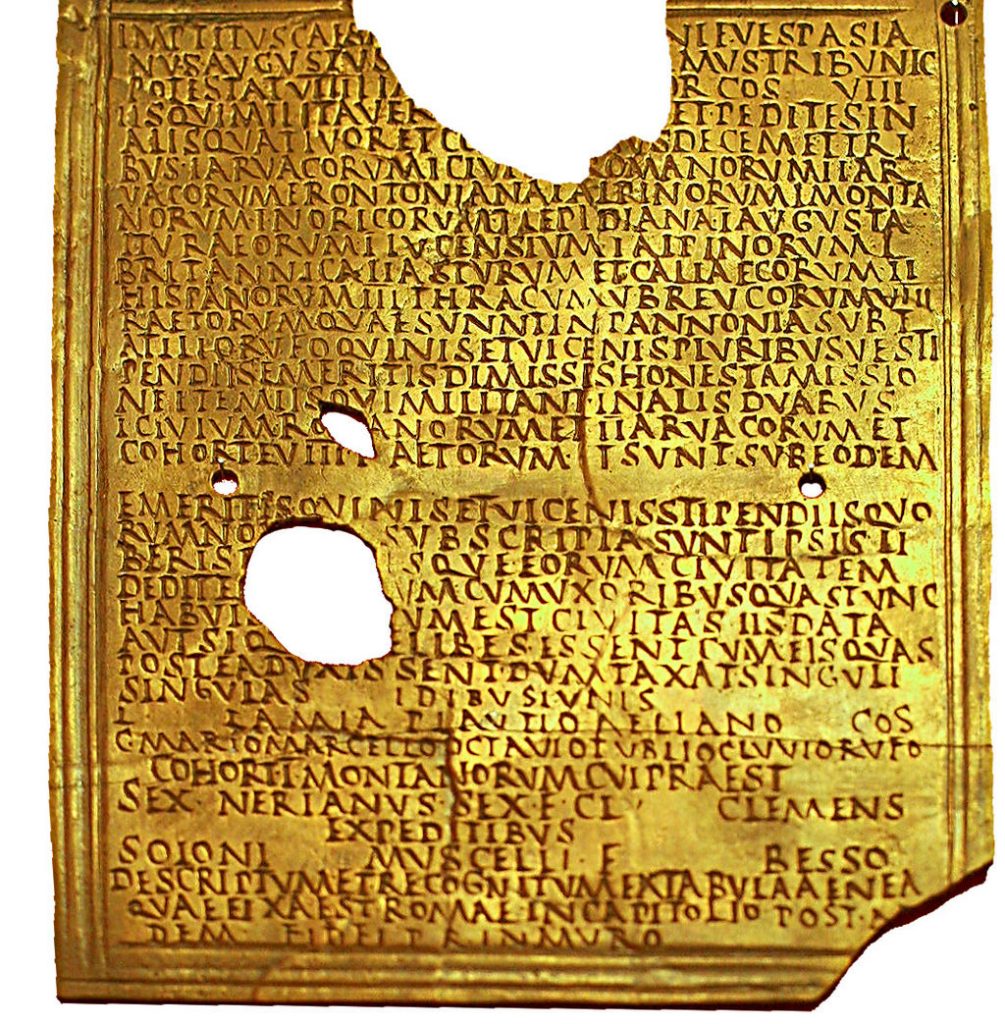 Military diplomas, like Basiel’s, consisted of 2 bronze tablets hinged together. Inscriptions would be engraved on each side of both plates. The full text of a diploma was engraved on the outer side of the so-called tabula 1, while the outer side of tabula 2 displayed the names of 7 witnesses, their seals covered and protected by metal strips (such seals have rarely survived, being of organic material). The text of tabula 1 was reproduced exactly on the 2 inner sides. The plates would then be folded shut and sealed together, so that the external inscription would be legible without breaking the seals. The internal inscription was the official notarised copy of the text on the constitutio published in Rome. The double-inscription and seals were presumably to prevent forgery or alteration.
Military diplomas, like Basiel’s, consisted of 2 bronze tablets hinged together. Inscriptions would be engraved on each side of both plates. The full text of a diploma was engraved on the outer side of the so-called tabula 1, while the outer side of tabula 2 displayed the names of 7 witnesses, their seals covered and protected by metal strips (such seals have rarely survived, being of organic material). The text of tabula 1 was reproduced exactly on the 2 inner sides. The plates would then be folded shut and sealed together, so that the external inscription would be legible without breaking the seals. The internal inscription was the official notarised copy of the text on the constitutio published in Rome. The double-inscription and seals were presumably to prevent forgery or alteration.
In a likely scenario, the holder would take the sealed diploma to the province or civitas (city/county) where he intended to live in retirement. He would then present the diploma to the keeper of archives either at the provincial governor’s headquarters (or perhaps at his local civitas offices). The archivist could break the seals and check that the data on the internal inscription matched the external one. If all was in order, he would then enter the diploma-holder’s name onto the register of resident Roman citizens.
Sadly Basiel’s diploma has been lost to history, another casualty of WWII. No-one knows what happened to it; it was either destroyed by a bomb or possibly looted.
In addition to the diploma several ballot boxes and an antique vase, placed upside down, were discovered next to a skeleton. The finds were, thankfully for us, passed on to the relevant Corsican Archaeological authorities. However no meaningful analysis was done until 1920 when French historian René Cagnat published his findings.
Who was Basiel ?
The name Basiel maybe a Celtic form of a Greek name. However Turbel definitely is a Celtic name*, which would fit as being from Gaul (modern day France) or the Channel Islands. Indeed the name Turbel is known to have persisted unaltered into the 20th century and may even also have morphed into Trubuil or Tabel.
* the ending el being Gallic and Turbel approaching similar forms of Turba(today Tarbes) and Tarbella
The form and use of two locations in “Gallinaria Sarniensis” to describe Basiel is unusual. It could mean that Basiel is from both locations or his father is from Gallinaria and he is from Sarniensis. In any case scholars think that it is most likely that Sarniensis DOES refer to Basiel.
If we consider that BOTH locations might refer to Basiel …
Gallinaria Sarniensis – the word order here is interpreted as follows :
| Gallinaria | Sarniensis |
| [ the locality from which he originated,or where Turbel was from ] | [ the territory to which the locality belongs or just where Basiel was from ] |
Only 2 Gallinarias are known, an island and a forest.
- Gallinaria the Island, today Gallinara, is located on the Ligurian coast opposite Albium Ingaunum, a little southeast of Genoa.
- Gallinaria the forest stretched along the coast of Campania, between the mouth of the Vulturne and Cumae.
Can we believe that our sailor was from either of these places ?
There are 2 objections :
- The island is very small and had few, if any, inhabitants.
- The Forest area is a possibility but the ethnic Sarniensis poses a problem – there is nowhere near this forest with that name.
The adjective Sarniensis leads, indeed, to a form like Sarnia or Sarnium; and only one place (a Channel Island) is known by this name, mentioned in the “Itinerary of Antoninus”, between Gaul and Brittany
Sarnia is recorded along with several other island names in the “Itinerarium Antonini Augusti*“
There is only one locality of this name known in antiquity (so far) and it appears among a list of ’15 islands in the Ocean between Gaul & Brittany’, but without indication of the exact position of each of the named islands.
*A register of the stations and distances along various roads. Based on official documents, possibly from a survey carried out under Augustus, it describes the roads of the Roman Empire.
| In mari oceano quod Gallias et Britannias interluit ** | Modern Name | Comments |
|---|---|---|
| Insule Orcades numero iii | Orkney islands numbering three | Clearly, should be thirty |
| Insule Clota in Hivernione | R.Clyde & Ireland | “Insula Clota in Hiverione” is strange, and can be interpreted in 2 ways, either as the Island Clota in the Hiverione sea or that Hiverione is a variant of Hivernione (Ireland), and it is generally agreed that Clota is not an island at all, but is actually the R. Clyde. |
| Vecta | Isle of Wight | |
| Riduna | Alderney | Conjecture |
| Sarnia | Sark | |
| Caesarea | Jersey* | There is in fact no real justification for Jersey being Caesarea and is probably Andium. It was called “Angia” in the post Roman document, the First Life of St. Samson of Dol, in which Guernsey also appears as Lesia – a corruption of Lisia |
| Barsa | ||
| Lisia | Guernsey | Guernsey also appears as ‘Lesia’ in the First Life of St. Samson of Dol – a corruption probably |
| Andium | Probably Jersey* | |
| Sicdelis | ||
| Uxantis | Ushant | |
| (S)Ina | Isle de Sein | Actually Sina (having lost its initial “S” in the text) |
| Vindilis | Belle Ile. | |
| Siata | Possibly Ile d’Houat | |
| Arica | Ile de Hoadic |
*In the sea that flows between the Gauls and the Britons
So we are left with only 1 location, that we know of to date, that fits Sarniensis and none near it that fits Gallinaria.
So if Basiel really was a son of Sark (or Guernsey) we might possibly conclude that Gallinaria must be a small locality on one of the islands, for which we have no documentary mention of as yet.
(other interpretations are possible though – see below)
There are, as always, other possible explanations.
If we consider that there are at least 3 spelling mistakes in the document – Caesar is twice misspelt as Caeser and most significantly we read Miseniense for Misenense. Then we may also further consider that Sarniensis may be a mistake derived from such a form of names as Sarnus, Sarno or Sarnum as well as our old favourite Sarnia.
If this were the case other opportunities present themselves for the Gallinaria-Sarniensis conundrum as follows.
Gallinaria Sarniensis – the word order here is interpreted as follows :
| Gallinaria (Silva) |
|
| [ the locality where Turbel was from the Forest in Southern Italia ] | [ a misspelling of the territory from which Basiel originated and he was actually from Samum, 50 miles from Gallinaria ] |
In Nuceria, a small district just south of Vesuvius and fronting the present Bay of Naples, there is a river called the Samus. It arises a few miles inland from a source at the foot of Mons Samo. No town of Samus, Samum or Sarno is known of HOWEVER in early post-classical times a town named Samum is mentioned by “the Geographer of Ravenna*” as standing near the source of the river.
*The Geographer of Ravenna is an anonymous cleric living in Ravenna around 700AD who compiled a work known as the “Ravenna Cosmography” – a list of place-names covering the world from India to Ireland.
Furthermore the Gallinaria Silva wood already referred to is only 50 miles away – with Misenum lying in between the two. That still leaves the problem of the celtic name of his father. It is possible though that Turbel emigrated to Samum or Gallinaria and that Basiel was born here. There is then no link back to the Channel Islands necessarily.
All this therefore relies on a spelling mistake, a celt emigrating to southern Italia and a village that we’re not sure ever existed at that time.
So take your pick. Of course we prefer the Sarniensis Channel Island link.
Distribution of Celtic settlements in the Roman Empire of the first century A.D.

Basiel Sarniensis – A Life in Context

“Basiel leaps into fame as being the first Channel Islander recorded in history”
~ Edith Carey in “Channel Islands, 1924
If Basiel of “Sarniensis” was released on the 5th April 71 AD after 26 years of service, he would have enlisted in the fleet in the year 45 AD, during the reign of Claudius. This means that towards the end of his career he would probably have been a participant in one of the most famous wars in history, the expedition of Rome against the Jews.
The First Jewish-Roman War
The war began in 66 AD, during the reign of Emperor Nero, when the Jews in Judea rose up against their Roman occupiers. The scale of the war would have necessitated a considerable movement of troops and supplies across the Mediterranean. It is entirely possible that Basiel the “Sarnian” was on the fleet transporting troops and equipment to Judea.
Vespasian, an experienced and unassuming general, was given the task, by Nero, of crushing the rebellion in Judea. Given four legions and assisted by forces of King Agrippa II, Vespasian invaded Galilee in 67 AD.
 The war ended in 70 AD with the capture and the total ruin of Jerusalem along with the temple on Temple mount. Its western Wall is the only surviving remnant visible today. It also resulted in the dispersion of the Jewish people.
The war ended in 70 AD with the capture and the total ruin of Jerusalem along with the temple on Temple mount. Its western Wall is the only surviving remnant visible today. It also resulted in the dispersion of the Jewish people.
Before the war was completed though Nero had committed suicide and after a brief civil war between 68-69 AD it was General Vespasian who assumed the mantle of Emperor.
Discharge
Diplomas were not normally issued to discharged legionaries, as the legions recruited Roman citizens only. However, legionary diplomas were exceptionally issued after the Civil War of 68/69 AD. As an emergency measure, 2 new legions, the I and II Classica (later reconstituted and renamed as I and II Adiutrix, respectively) were formed mainly from naval marines, many of whom did not hold citizenship. At the end of the crisis, these were all awarded Roman citizenship.
It is also possible therefore that Basiel was a marine co-opted into these legions and this formed the basis of his discharge . However because it is not specifically mentioned in the diploma this is unlikely.

We can reasonably conclude then that Basiel was part of this demobilisation so that on 5th April 71 AD after 26 years of service he was paid off and released from service in the Roman Navy.
Whatever the reason for Basiel’s granting of citizenship, in the aftermath of the victory and civil strife, Rome realized that its finances were in a ruinous state. Vespasian therefore proceeded with a general “demobilization” of men and materials. The soldiers and sailors who had served their allotted time were given a payment (stipendia), titles of honour , citizenship and a return to civilian life. We can reasonably conclude then that Basiel was part of this demobilisation so that on 5th April 71 AD after 26 years of service he was paid off and released from service in the Roman Navy.
What happened to him after that we will never know. Was the body found near the plaque him ? or did he return to his native Sarnia ?

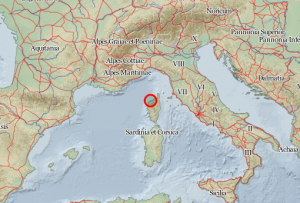
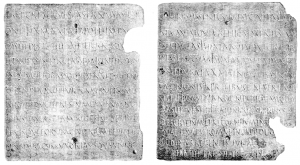
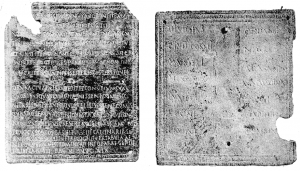
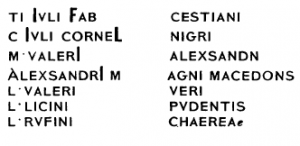






You must be logged in to post a comment.